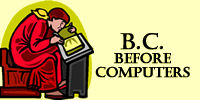 Many people say the internet is the greatest invention since the printing press. Before the internet people read books. Books, words on paper, published ideas, were the basis of mass communications for many centuries prior to 20th century technology.
Many people say the internet is the greatest invention since the printing press. Before the internet people read books. Books, words on paper, published ideas, were the basis of mass communications for many centuries prior to 20th century technology.
The Sumerians in Mesopotamia started to develop the basics of communication with writing and alphabets around 3000 B.C. In the centuries that followed the first permanent storage devices, hand written books, were developed.
The manuscript culture of the Middle Ages dealt with the making and trade of manuscripts. In early manuscript culture monks copied manuscripts by hand, mostly religious texts.
Xerox had one of the most popular TV commercials that aired in the 1970s with the 1975 "Miracle Monks" spot. In the commercial a monk used a a Xerox duplicating system to produce copies of a manuscript. The commercial won just about every award it could, and embedded in the minds of a generation the concept of the chubby cherub scribe as the predecessor to the modern copy machine.
Mass communication involves information distribution in a "one to many" form of communication.
The First Information Explosion, and next era in the history of Information Technology known as the Mechanical Age, is usually attributed to the printing press created by Johannes Gutenberg around 1450.
Although the Chinese had created various types of printing devices centuries earlier, the invention of the printing press is typically attributed to Johannes Gutenberg for his movable type system that led to the first mass production of books in Europe.
Gutenberg was aware that a successful launch of his new invention would be much easier if they began with a high profile book of importance beyond their local area so they chose to publish the Bible. According to the Library of Congress, the printing of The Gutenberg Bible, also known as the 42 line Bible, was probably completed late in 1455 at Mainz, Germany.
The term mass media was coined in the 1920s with the advent of nationwide radio networks, mass-circulation newspapers and magazines. However, some forms of mass media such as books and manuscripts had already been in use for centuries.
Telecommunications is the transmission of messages, over significant distances, for the purpose of communication.
Electrical telegraph networks were the first form of electrical telecommunications that empowered people and commerce to transmit messages across continents and oceans with widespread social and economic impacts.
Samuel F. B. Morse developed an electrical telegraph that was capable of transmitting over long distances using poor quality wire. His assistant, Alfred Vail, developed the Morse code signaling alphabet with Morse. On January 6, 1838, Morse first successfully tested the device.
In 1861 the first transcontinental telegraph system was established. Eventually the telegraph network crossed the oceans to every continent (except Antarctica) making instant global communication possible for the first time.
The next step in the evolution of telecommunications was the telephone, a device that converts sound into electronic signals for long distance transmission over wires.
In out next article we will answer the question, who invented the telephone. The answer may not be as simple as you think.
